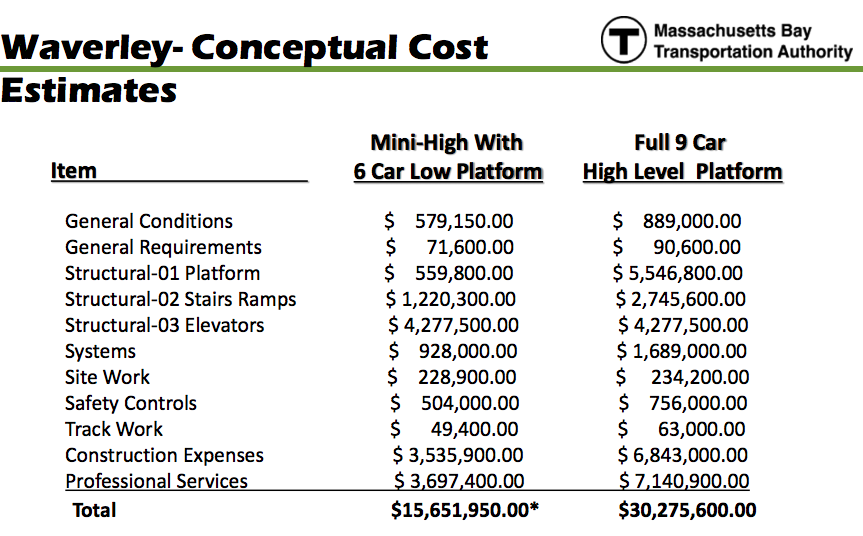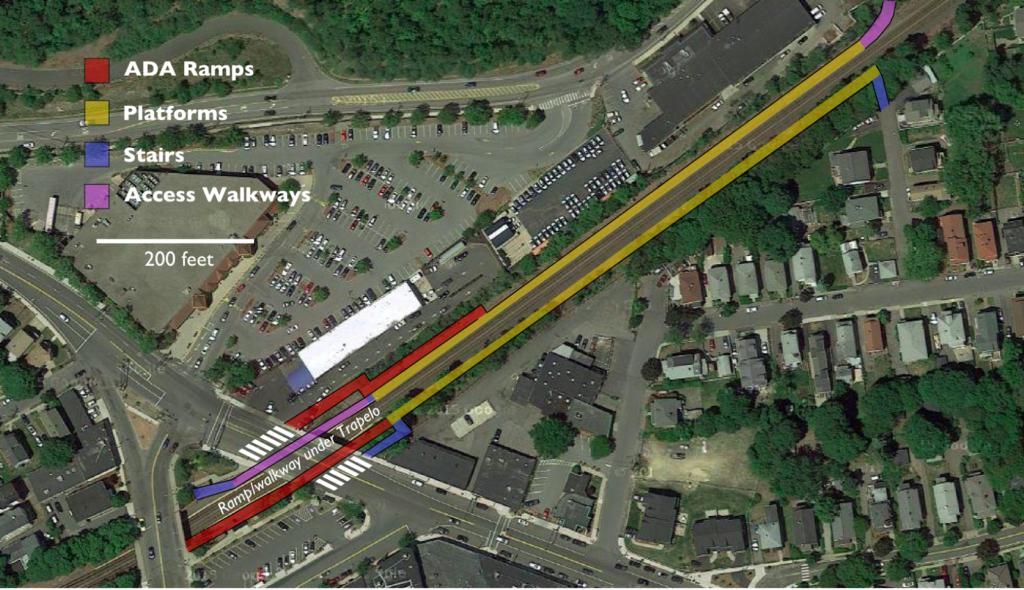Belmont might be getting a new Commuter Rail station. This is not a good thing. Why? Because the T is proposing to create a new parking-oriented station which is within walking distance of far fewer customers than the current stations, and then close those stations.
Really.
In 2012, the MBTA performed enough maintenance on the platforms at Waverley Square that it required them to bring the station in to compliance with the Americans with Disabilities act. The problem? The station was built in 1952 when the grade separation there was built (the second-to-last of the B&M’s grade separation investments; Winchester was the last) and is in a deep trench, with 20 feet of steps separating the railroad from the roadway.
Now, if a sensible organization were in charge, they’d spec a new station at Waverley accessed by ramps from the street above, full-length, high-level platforms, and build a new station. On the south (inbound) side, there is plenty of room for a ramp from street level to the platform (especially since with a four-foot-high platform, you only need to descend 20 feet). The width of the south side of the station is about 200 feet, so it’s a single-zig ramp to get up and down with about three landings on each. The right-of-way, which held three tracks until the grade separation, is 100 feet wide, so the north side (outbound) platform could be accessed by a ramp to the east of the station to a rebuilt platform, with the current stairwell providing access from the narrow part of the triangle. Alternatively, platforms could be moved to the east of the station where the line is straighter, and the current station area used for vertical circulation.
In Belmont Center, the solution is easier. It would be hard to build new platforms at the current station location, which is located on a curve and would necessitate a Yawkey-style double-platform solution: a costly endeavor. However, just east of station the tracks straighten out and the right-of-way is 84 feet wide, plenty for a pair of platforms and two tracks. The north side of the station would be accessible with a ramp in place of a short staircase and a short ramp to a high level platform, which could be build to the east of the current platform. The south side would require a longer series of ramps, probably just east of the station. But again, this is not insurmountable.
But what does the T want to do? The T wants to close both stops and build a new station in between. This new station would be within walking distance of fewer residents, and much further from the downtown employment areas at Belmont and Waverley (as well as McLean Hospital, the largest employer in the town). It would have a parking lot, so a lot of people who currently walk to the train station would have to drive. It would sever connections between the bus lines which serve Belmont and Waverley and the train station. (Do you live in Waltham and work at Mount Auburn Hospital? Say goodbye to your rail-bus commute, you’ll have to take the train in to Porter, the Red Line to Harvard, and the bus out.)
Does this make any sense? If you’re a Belmont resident, it does not. Apparently, if you’re the MBTA, it does.
Here is a quick table of the current stations and their catchment areas (defined as the total population of all census blocks all of part of which are within 0.5 miles of the station location):
Belmont (current): 4311
Waverley (current): 7452
Proposed location: 7019
So not only does the proposed location serve far fewer residents than the current two stations, it actually serves fewer residents than the currently Waverley Square station!
How does the T justify this farce of a plan? The same way the justified killing the Red-Blue connector: by wildly inflating the cost of the plan they don’t want (bringing the current stations in to compliance) and giving few if any details about the costs of what they want to build. Their estimated cost for rebuilding each of the Belmont stations? $35 million (well, they’ve now come down to $16 to $30 million). Their number for a new station? They can’t say, but think it will be less. This is so entirely disingenuous it knocks my socks off.
Let’s look at some data to see how far off these numbers are, looking at some recent station construction for MBTA stations with full, high-level platforms and note whether it was a rebuild or a new station and the type of vertical circulation:
Yawkey Station (Worcester Line), 2014: $13.5 million
Existing station. built on a curve, in a narrow corridor, required track realignment, and elevators.
Boston Landing (Worcester Line), 2016, $20 million
New Station, ramps
Newmarket Station (Fairmount Line), 2013, $12.3 million
New Station, ramps.
Uphams Corner (Fairmount Line), 2007, $7 million
Existing station, ramps.
Four Corners/Geneva (Fairmount Line), 2013, $17.7 million
New station, ramps.
Talbot Ave (Fairmount Line), 2013, $15.9 million
New station, project cost included a new bridge, ramps.
Morton Street (Fairmount Line), 2006, $6.5 million
Existing station, ramps.
Blue Hill Ave (Fairmount Line), 2017, $10 million
New station, center platform, ramps.
South Acton (Fitchburg Line), 2015, $9.6 million
Existing station, elevators. The T is willing to flat-out lie about the construction costs by including land acquisition costs, which are not an issue for either station here, considering the 100-foot right-of-way.
Littleton (Fitchburg Line), 2014, $8 million
Existing station, center platform ramps.
So let’s review. Existing stations upgraded to full high level platforms built in the last 10 years have ranged in cost from $6.5 million to $13.5 million, with an average cost of $8.9 million. New stations built with full high levels have ranged from $10 million to $20 million, with an average cost of $15.1 million (the ones with elevators cost more, and elevators have higher maintenance costs). So the T is being disingenuous in two dimensions. First, upgrading the two existing stations, based on these averages, would cost only slightly more than building a new station. And secondly, recent experience shows the price would be nowhere near $35 million dollars for each station. Not even in the ballpark!
In fact, the T’s own planning documents admit this and quotes a cost of $15–$18 million for stations with side platforms (double the cost of recent station rebuilds, but still nowhere near the $35 million figure) and $22–$30 for (new) center platform stations (based on the cost of the Boston Landing station, although Blue Hill Ave is center platform and half the cost of Boston Landing). So while this planning document inflates the cost of upgrading stations, it still doesn’t get it to the $35 million level. And the claims that new stations cost more than rebuilding existing stations are just wrong.
Now, the T will claim that the new station is needed because the current stations are underutilized. This is hokum. The current stations are underutilized for two very good reasons: frequency and fare policy. First, frequency:
Inbound:
Waverley: 9 departures, 3 peak, 2 reverse commute, 4 off-peak
Belmont: 14 departures, 4 peak, 2 reverse commute, 8 off-peak
Outbound:
Waverley: 12 departures, 4 peak, 2 reverse commute, 6 off-peak
Belmont: 13 departures, 4 peak, 2 reverse commute, 7 off-peak
If you’re in Waverley and you don’t need to get to North Station at a very specific time, it’s better to take the 73 bus to Harvard and the Red Line. The 19 minute travel time is half of the bus-subway route, but it only runs once an hour. In Belmont, you have a few more choices and fewer buses, but there’s still no frequency. Schedules are uneven, and some midday trains skip the stations. Departures should be rationalized once the line has full double-tracking, but the stations won’t attract more passenger without more service. Building a different station won’t help.
Then there’s the fares. A trip on the bus and subway from Belmont to downtown costs you $2.10, or $75 for a monthly pass. A train ticket? That comes at $5.75, or $182 for the month, nearly triple the cost. This is a longer discussion about T fare policy, but it doesn’t help drive ridership in Belmont. Still, neither is an argument to build a station which will serve fewer people. (And, no, a new station won’t be an express stop: the “super express” from South Acton doesn’t even stop at Waltham.)
So what’s going on here? I’m not sure if it’s a question of incompetence or something more nefarious. But it seems to be in line with a lot of what goes on with a lot of Massachusetts infrastructure projects: create an agenda (single station in Belmont), create a plan that is unpalatable to the community (less access, more traffic) and make up costs so that your agenda compares so favorably that it is the only logical option. Then advance it far enough that it’s illogical to turn back. We saw this with Red-Blue connector, which has cost estimates the Globe has called “deliberately high.” We’ve seen it in Allston, where this page has argued that the state is pursuing a far more expensive plan by being immovable on project guidelines and refusing to fully vet better alternatives (although there is some progress being made). Unfortunately, this Belmont “plan” fits the pattern all too well.
What should we do? Contact your legislator, especially if you live in or near Belmont. Go to meetings. Raise your voice. And let the T know that they can’t get away with further degrading Commuter Rail service by making up numbers.
Part 2 takes a deeper look at these numbers, and finds them to be no less made up.


